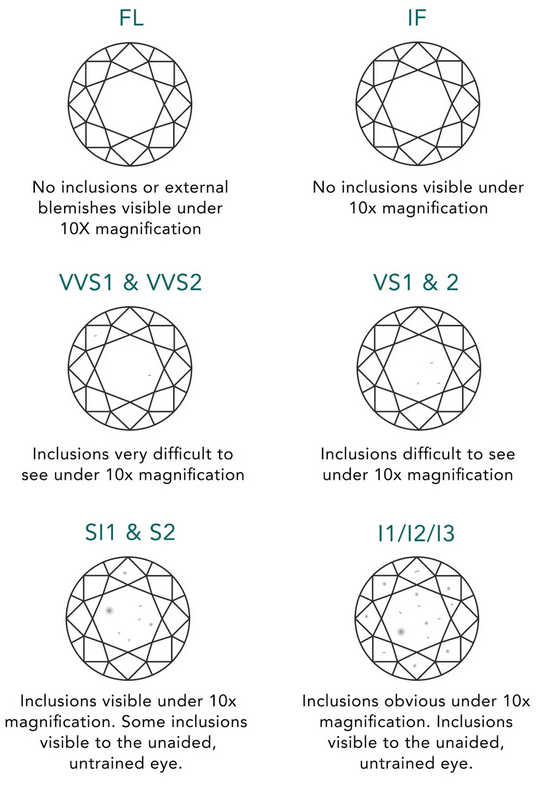
Diamond Buying Guide
What is a Diamond?
A diamond is a naturally occurring mineral composed primarily of carbon, renowned for its exceptional hardness, brilliance, and beauty. Formed deep within the Earth’s mantle under high pressure and temperature conditions, diamonds are brought to the surface through volcanic eruptions. These precious gemstones undergo cutting and polishing to unlock their full potential, revealing their remarkable sparkle and fire.
Diamonds are renowned for their enduring symbolism of love, commitment, and luxury, making them a popular choice for engagement rings, wedding bands, and other fine jewellery pieces. Their timeless allure transcends generations, representing strength, purity, and eternal beauty.
Beyond their aesthetic appeal, diamonds hold significant economic and cultural value. They are prized for their rarity, with natural diamonds forming over billions of years, and for their role as a store of wealth and investment. However, in recent years, technological advancements have led to the development of lab-grown diamonds, which possess the same physical, chemical, and optical properties as natural diamonds but are created in controlled laboratory environments. These lab-grown diamonds offer a sustainable and ethical alternative to mined diamonds, aligning with the growing demand for responsible and eco-conscious jewellery options.
Explore our curated collection of lab-grown diamond jewellery to find the perfect expression of your unique style and sentiment. To continue learning about diamonds and which one is perfect for you, read more:
What are the 4 C's
The 4 C’s refer to the four key characteristics that determine the quality and value of a diamond are:
Understanding the 4 C’s allows you to make informed decisions when purchasing diamonds, ensuring that you select stones that meet your desired specifications and budget while maximising beauty and quality.
These were created by the Gemological Institute of America (GIA) to standardise how diamonds are graded across the world and increase transparency in the industry. Since lab-grown diamonds are real diamonds, they are graded exactly as per the GIA natural diamond grading system, with the exact same parameters used for mined diamonds. The 4C’s of lab-grown diamonds will vary, just like in natural diamonds, and they can range in grade from poor to excellent.
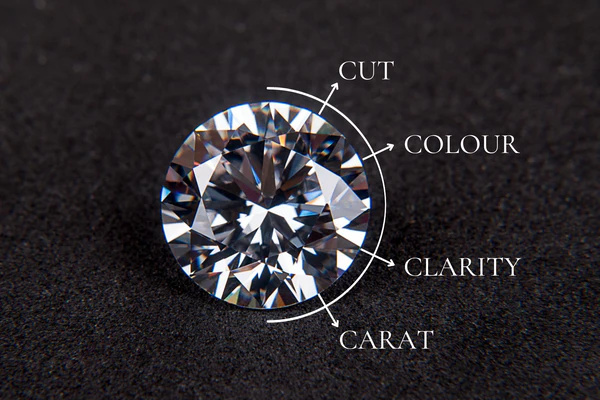
Carat Weight: Carat weight measures the size of the diamond and is often the most noticeable factor in its appearance. One carat is equivalent to 0.2 grams, and diamonds are typically weighed to the nearest hundredth of a carat. As carat weight increases, so does the rarity and value of the diamond.
Cut: Cut refers to the proportions, symmetry, and polish of a diamond, as well as the arrangement of its facets. A well-cut diamond maximises its brilliance, fire, and scintillation by allowing light to reflect and refract through the stone effectively. The cut grade is crucial in determining the diamond's overall sparkle and beauty.
Colour: The colour grade of a diamond refers to the absence of colour, with the highest-quality diamonds being colourless. Diamond colour is graded on a scale from D (colourless) to Z (light yellow or brown). Colourless diamonds allow more light to pass through, enhancing their brilliance and value.
Clarity: Clarity measures the presence of internal flaws (inclusions) and external blemishes within a diamond. The clarity grade indicates the diamond's purity, with higher grades representing fewer inclusions and blemishes. The clarity scale ranges from Flawless (no inclusions or blemishes visible under 10x magnification) to Included (inclusions visible to the naked eye).
Carat
Carat is the unit of measurement for the physical weight of diamonds and is the most objective measurement of the “Four C’s” for determining the value of a diamond. One carat is equal to 200 milligrams, or 1/5 gram, and is subdivided into 100 “points”. This allows very precise measurements to the hundredth decimal place.
This diagram illustrates the typical size relationship of different diamond shapes in increasing carat weights.
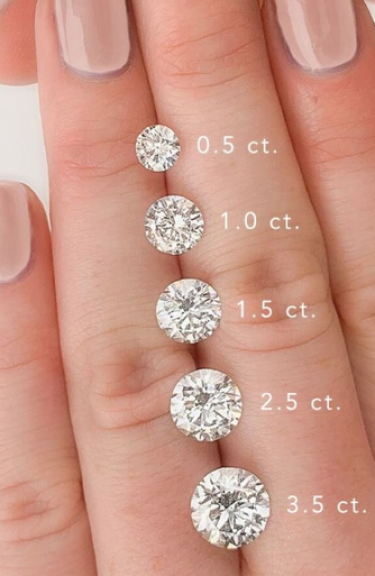
Round

Oval
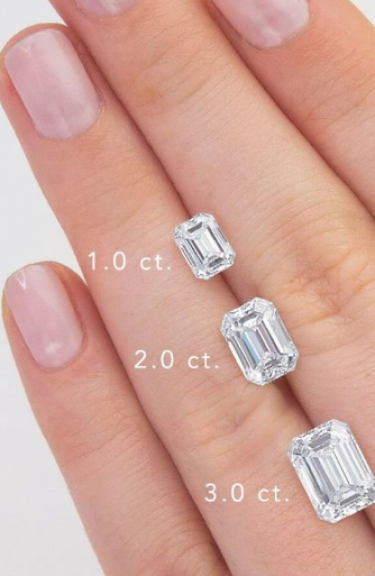
Emerald
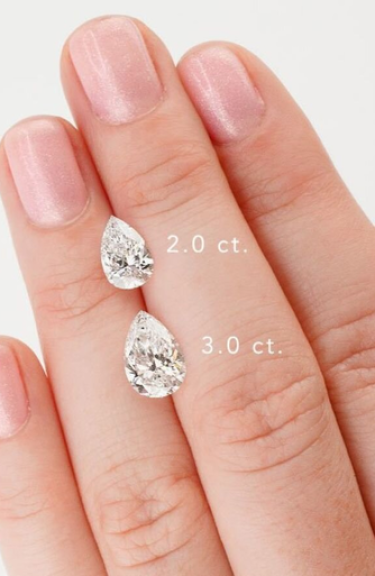
Cushion
Cut
A diamond’s cut doesn’t just refer to its shape, it determines how well the diamond captures and refracts light, which produces its inimitable sparkle. Well-cut diamonds are extremely brilliant, fiery, and desirable. Poor-cut diamonds, on the other hand, can appear dull and dark even if they have a high grade of colour or clarity. The diamond cut includes the proportions, symmetry, and polish of a diamond, as well as the arrangement of its facets. The intense radiance of well-cut diamonds also gives them the illusion of appearing larger than other diamonds of the same carat weight. Ideal diamonds have elevated levels of brilliance compared to diamonds with deeper cuts.
Diamond cuts range from Super Ideal to Poor. See the image to understand the differences between ‘cuts’ better.


Colour
Diamond colour refers to the absence of colour in a diamond, with the highest-quality diamonds being colourless. The presence of colour in a diamond can affect its appearance and value. Diamond colour is graded on a scale that ranges from D (colourless) to Z (light yellow or brown).
Here’s a breakdown of the diamond colour scale:
Diamonds in the D-F range are considered colourless and are extremely rare. They allow the most light to pass through, resulting in maximum brilliance and fire. These diamonds are highly desirable and command a premium price.
Diamonds in the G-J range have slight traces of colour that are difficult to detect to the untrained eye, especially when set in jewellery. They offer excellent value for those seeking high-quality diamonds without the premium associated with colourless grades.
Diamonds in the K-M range exhibit noticeable colour tinting, typically yellow or brown, especially when viewed against a white background. While they may offer value for budget-conscious buyers, their colour may detract from their overall appearance.
Diamonds in the N-R range have a more pronounced colour tint and are considered lower quality. They may appear visibly yellow or brown, especially to the naked eye.
Diamonds in the S-Z range have the most noticeable colour tint and are considered lower quality. They often exhibit a yellow or brown hue that can significantly impact their appearance and value.
It’s important to note that diamond colour grading is performed under controlled lighting conditions and against standardised comparison stones. This ensures consistency and accuracy in assessing the diamond’s colour.

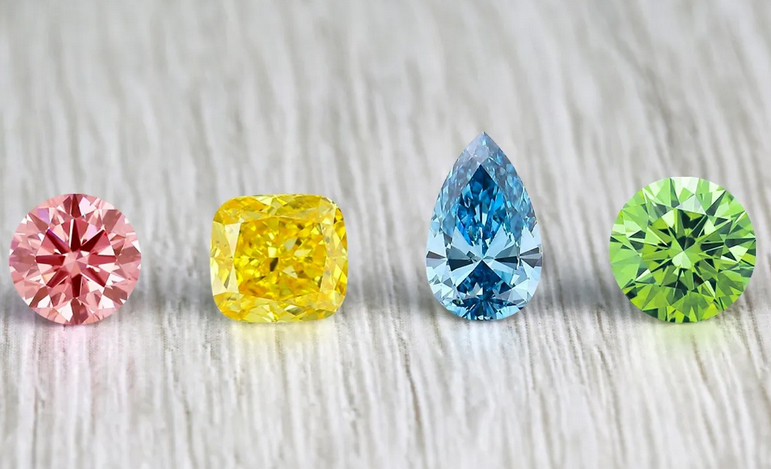
Fancy Coloured Diamonds
Fancy-coloured diamonds feature colours that extend beyond the normal colour range of D-Z. They are incredibly rare and come in every colour of the rainbow, including blue, green, pink, yellow, orange, and red.
While diamonds within the normal range decrease in value as their colour becomes more apparent, the opposite is true for fancy-coloured diamonds: their value increases exponentially with the strength and purity of the colour. Generally, the more vivid a fancy-coloured diamond is, the more expensive it’ll be.
Clarity
Diamond clarity refers to the presence or absence of internal flaws (inclusions) and external blemishes within a diamond. These imperfections can affect the diamond’s appearance, brilliance, and overall value. Clarity is graded on a scale that ranges from Flawless (FL) to Included (I). The clarity of a diamond is always measured under a 10x microscope in ideal lighting conditions.
It’s important to remember that while a diamond may have inclusions or blemishes, these imperfections may not be visible to the untrained, unaided eye. Diamonds with inclusions or blemishes that aren’t visible to the naked eye are called ‘eye clean.’ If you’re looking for a high-clarity diamond, ensuring it’s eye is clean is the most important factor.
